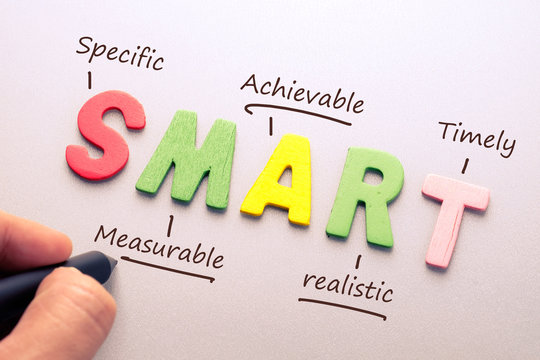In the pursuit of personal growth and self-improvement there are many options and some individuals turn to life coaching to help them navigate their journey. Life Coaches all have their own way of working but to be most effective, it is important to have a trusting and comfortable relationship with your coach. Sometimes you might be challenged and held to account. Everyone is different and therefore there is no set rule on how to reach your goals.
One of the tools sometimes used during sessions though is the SMART model, an effective framework for setting and achieving goals. Whether you’re new to life coaching or simply looking to enhance your goal-setting strategies, understanding the SMART model might be a tool that works for you. In this blog, I will explain the SMART model—what it is, why it works, and how you can apply it to various aspects of your life.
What is the SMART Model?
The SMART model is a goal-setting framework that stands for Specific, Measurable, Achievable, Relevant, and Timely. This model helps individuals set clear, realistic, and structured goals, thereby increasing the likelihood of success.
- Specific: Goals should be clear and unambiguous. A specific goal answers questions such as who, what, where, when, and why. It provides a clear direction and leaves no room for misunderstanding.
- Measurable: A goal must have criteria for measuring progress. This allows you to track your progress and stay motivated. Measurement answers the question of how you will know when the goal is achieved.
- Achievable: Goals should be realistic and attainable. While it’s essential to challenge yourself, it’s equally important that your goals are within your capabilities. This ensures that your goal is not just a dream but something you can realistically accomplish.
- Relevant: Your goals should matter to you and align with other relevant goals. They should fit into your broader life plans and values, ensuring that you are moving in a direction that is meaningful to you.
- Timely: Every goal needs a target date, creating a sense of urgency and prompting you to prioritise your goal. A timeline helps prevent goals from being overtaken by day-to-day tasks.
The effectiveness of the SMART model lies in its structure and clarity. By breaking down goals into specific, measurable, achievable, relevant, and timely components, it transforms vague aspirations into actionable plans. This structured approach helps to:
- Clarify Vision: Specific goals provide a clear vision, eliminating ambiguity.
- Boost Motivation: Measurable goals allow you to see your progress, boosting motivation.
- Ensure Realism: Achievable goals keep you grounded, ensuring that you set realistic expectations.
- Maintain Relevance: Relevant goals ensure that your efforts are aligned with your larger life objectives.
- Create Urgency: Timely goals create a sense of urgency, helping you prioritise and focus.
Applying the SMART Model to Different Life Situations
Let’s explore how you can apply the SMART model to various aspects of your life, from personal development and career advancement to health and relationships.
1. Personal Development
Goal: Improve Time Management Skills
- Specific: “I want to improve my time management skills to balance work and personal life better.”
- Measurable: “I will use a planner to schedule my daily tasks and review my productivity weekly.”
- Achievable: “I will dedicate 10 minutes each evening to plan the next day and 5 minutes each morning to review my plan.”
- Relevant: “Improving my time management will help reduce stress and increase my productivity, aligning with my goal to achieve a better work-life balance.”
- Timely: “I aim to establish this habit within the next three months.”
By breaking down the goal using the SMART model, you create a clear, actionable plan that is easy to follow and track.
2. Career Advancement
Goal: Earn a Promotion
- Specific: “I want to earn a promotion to a managerial position in my current department.”
- Measurable: “I will complete two professional development courses and take on three new projects within the next year.”
- Achievable: “I will allocate time each week for courses and actively seek feedback from my supervisor on my project performance.”
- Relevant: “Earning a promotion aligns with my long-term career goal of moving into leadership roles.”
- Timely: “I aim to earn the promotion within the next 18 months.”
This approach ensures that your career advancement goal is well-defined and within reach, with a clear timeline and actionable steps.
3. Relationships
Goal: Improve Communication with Partner
- Specific: “I want to improve my communication skills to strengthen my relationship with my partner.”
- Measurable: “I will set aside 20 minutes each evening for uninterrupted, meaningful conversation with my partner.”
- Achievable: “We will both commit to this practice and seek to address any barriers to communication as they arise.”
- Relevant: “Improving communication will enhance our relationship and resolve conflicts more effectively.”
- Timely: “We aim to establish this routine within the next month and review our progress monthly.”
Setting a SMART goal for improving communication in a relationship creates a structured approach to enhance mutual understanding and connection.
Tips for Implementing the SMART Model
- Start Small: Begin with small, manageable goals to build confidence and momentum.
- Stay Flexible: Be prepared to adjust your goals as needed. Life is dynamic, and flexibility is key to staying on track.
- Seek Support: Don’t hesitate to seek support from friends, family, or a life coach to help you stay accountable.
- Celebrate Milestones: Acknowledge and celebrate your progress along the way to stay motivated.
- Reflect and Adjust: Regularly reflect on your progress and make necessary adjustments to your goals or strategies.
Conclusion
The SMART model is one of many tools in life coaching, offering a structured approach to setting and achieving goals. By ensuring your goals are Specific, Measurable, Achievable, Relevant, and Timely, you create a clear roadmap for achieving what you aspire to. Whether you’re focusing on personal development, career advancement, health, or relationships, the SMART model can help you turn your aspirations into reality. You can try it out yourself and see how you get on. If you would like to have a few coaching sessions with us at Positive Futures Coaching we can introduce you to many other tools and give you the time and space to find those that really do work for you for the long term. We look forward to hearing from you.


